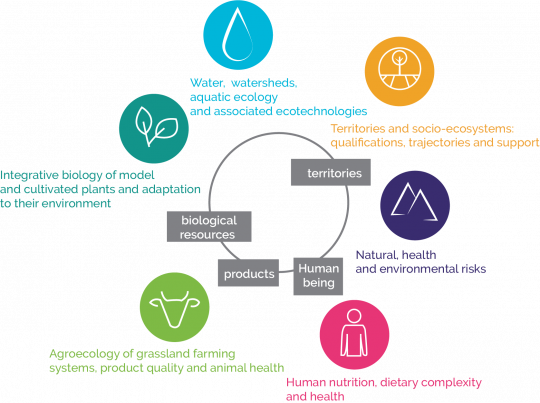Research at the Lyon-Grenoble Auvergne-Rhône-Alpes Centre
INRAE features one of its largest operations in the Auvergne-Rhône-Alpes region, with some 1,400 staff in total in 41 separate units. It is organised into 2 research centres, Clermont-Auvergne-Rhône-Alpes and Lyon-Grenoble Auvergne-Rhône-Alpes. The 500 staff members in the Lyon-Grenoble Auvergne-Rhône-Alpes centre work in 22 research units, 10 of which are joint research units with INRAE as joint supervisor, plus one research support unit and 7 collective types of infrastructure (experimental halls, technical platforms and facilities). These are spread across a large part of the Rhône-Alpes area in 9 separate regional geographic locations. The centre is active in a very wide range of fields: water and associated ecotechnologies, natural, health and environmental risks, territories and socio-ecosystems, integrative biology of plants and their adaptation to their environment, and human nutrition and how it is linked to health. As a result, the centre’s research units contribute to the activities of 10 of the Institute’s 14 scientific divisions.
Our research areas
In order to ensure regional consistency, the 2 regional centres work within a common scientific framework, which sets out the range of research offered by INRAE in the Auvergne-Rhône-Alpes Region.


6 priority research areas
- water, watersheds, aquatic ecology and associated ecotechnologies;
- natural, health and environmental risks;
- territories and socio-ecosystems: qualifications, trajectories and support;
- integrative biology of model and cultivated plants and adaptation to their environment;
- human nutrition, dietary complexity and health;
- agroecology of grassland farming systems, product quality and animal health.
The centre's 22 research and service units
| Sigle de l'unité | Intitulé de l'unité | Tutelles | Fiche de présentation |
|---|---|---|---|
| AGE | Agroecology and environment | ISARA (USC) | AGE fact sheet pdf - 524.11 KB |
| BF2i | Functional Biology, Insects and Interactions | INRAE / INSA (UMR) | BF2I FACT SHEET pdf - 506.52 KB |
| CarMeN | Cardiovascular diseases, Metabolism, Diabetology and Nutrition Laboratory | INRAE / INSERM / UCBL (UMR) | CARMEN FACT SHEET pdf - 735.54 KB |
| CARRTEL | Alpine Centre for Research on Lake Ecosystems and Aquatic Food Webs | INRAE / USMB (UMR) | CARRTEL FACT SHEET pdf - 569.25 KB |
| CASPER | Characterization and Surveillance of Pesticide Resistance | ANSES (USC) | CASPER FACT SHEET pdf - 607.41 KB |
| CCSD | Center for Direct Scientific Communication | INRAE / CNRS / Inria / UdL (UMS) | CCSD fact sheet pdf - 327.47 KB |
| EPIA | Epidemiology of Animal and Zoonotic Diseases | INRAE / VetAgro Sup (UMR) | EPIA FACT SHEET pdf - 601.05 KB |
| GAEL | Grenoble Applied Economics Laboratory | INRAE / CNRS / Grenoble INP-UGA / UGA (UMR) | GAEL FACT SHEET pdf - 697.81 KB |
| IGE | Institute for Environmental Geosciences | INRAE / CNRS / GrenobleINP - UGA / IRD / UGA (UMR) | IGE FACT SHEET pdf - 379.72 KB |
| IGFL | Institute for Functional Genomics of Lyon | CNRS / ENS / UCBL (USC) | IGFL FACT SHEET pdf - 260.18 KB |
| IVPC | Viral Infections and Comparative Pathology | INRAE / EPHE / UCBL (UMR) | IVPC FACT SHEET pdf - 698.92 KB |
| LEHNA | Laboratory for Ecology of Natural and Man-impacted Hydrosystems | Université Lyon 1 / CNRS (USC) | LEHNA FACT SHEET pdf - 658.15 KB |
| LEM | Microbial Ecology Laboratory | INRAE / CNRS / UCBL / VetAgroSup (UMR) | LEM FACT SHEET pdf - 514.21 KB |
| LER | Rural Studies Laboratory | ISARA / Université Lyon 2 (USC) | LER FACT SHEET pdf - 718.76 KB |
| LESSEM | Laboratory for Mountain Ecosystems and Societies | INRAE (UR) | LESSEM FACT SHEET pdf - 320.49 KB |
| LPCV | Plant and Cell Physiology Laboratory | INRAE / CEA / CNRS / UGA (UMR) | LPCV FACT SHEET pdf - 305.89 KB |
| OSUG | Observatory for Sciences of the Universe of Grenoble | CNRS / IRD / Météo France / UGA (UMS) | OSUG FACT SHEET pdf - 450.71 KB |
| RDP | Plant Reproduction and Development | INRAE / CNRS / ENS / Inria / UCBL (UMR) | RDP fact sheet pdf - 379.91 KB |
| REVERSAAL | Reduce, Reuse, Recover Wastewater Resources | INRAE (UR) | REVERSAAL FACT SHEET pdf - 736.27 KB |
| RiverLy | Functioning of hydrosystems | INRAE (UR) | RiverLy fact sheet pdf - 641.93 KB |
| RS2GP | Wild Rodents, Health Risks and Population Management | VetAgro Sup (USC) | RS2GP FACT SHEET pdf - 564.22 KB |
| SBRI | Stem Cell and Brain Research Institute | INSERM / UCBL (USC) | SBRI FACT SHEET pdf - 423.72 KB |
